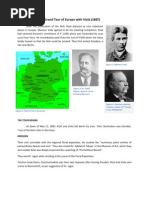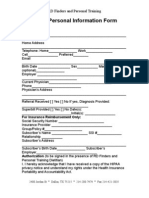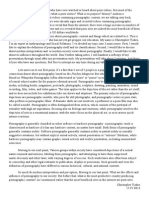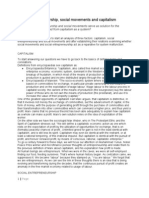STORIES Your GUIDE Won't Tell You About VIENNA
STORIES Your GUIDE Won't Tell You About VIENNA
Uploaded by
Marius DumitrascuCopyright:
Available Formats
STORIES Your GUIDE Won't Tell You About VIENNA
STORIES Your GUIDE Won't Tell You About VIENNA
Uploaded by
Marius DumitrascuOriginal Description:
Original Title
Copyright
Available Formats
Share this document
Did you find this document useful?
Is this content inappropriate?
Copyright:
Available Formats
STORIES Your GUIDE Won't Tell You About VIENNA
STORIES Your GUIDE Won't Tell You About VIENNA
Uploaded by
Marius DumitrascuCopyright:
Available Formats
STORIES your GUIDE wont tell you about VIENNA
Funded by the City of Vienna Gefrdert aus Mitteln der Stadt Wien
This publication was made for WIENWOCHE 2012 Entstanden im Rahmen von WIENWOCHE 2012
www.wienwoche.org
Research and mediation: Karin Schneider Photos and texts: Tal Adler English editing: Rod Pritchard-Smith Print: Rema print, Vienna ISBN: 978-3-9503456-1-2 Tal Adler The works in this publication are from the projects: Leveled Landscapes by Tal Adler Dispersed Fragments by Tal Adler and Karin Schneider produced in the frame of the FWF project MemScreen at the Academy of Fine Arts Vienna Further information: www.memscreen.info
Thanks: Dr. Willi Urbanek, Bezirksmuseum 1090 Reg.Rat Felix Czeipek, Bezirksmuseum 1040 Ina Markova Dr. Martha Keil, Institut fr jdische Geschichte sterreichs Wolfgang Scheyer, SOLA Yuval Kedem, GALILEO Pablo Farassat Sheri Avraham, Maria Muhar, Andreas Nader, Anna Szke, Lukas Wagner, Osama Zatar
Austrian Science Fund: AR 96-G21
STORIES your GUIDE wont tell you about VIENNA
Let us go on a short trip through the Austrian capital, Vienna. A beautiful, lively city full of culture, and a rich history awaits us, visitors and locals alike, everywhere. This illustrated guided tour will take you to some very ordinary and notso ordinary places. Each place is connected, and will lead you to the next one. This guide will tell you the stories about these places that most guides ignore. These are the stories behind the stories most guides tell. These are the stories of how most guides stories are constructed and told. These are the stories of why some stories are never told. These are the stories that need to be told. Curious? Lets go!
St. Stephens Cathedral (Stephansdom)
With 5.2 million visitors per year, St. Stephens Cathedral is Austrias most visited site and is known as THE most recognized symbol for Vienna and Austria. It is also a good place to start our tour as it demonstrates, like many other Austrian symbols, how history and memory are constructed in Austria. It is common knowledge that the cathedral was destroyed in April 1945 by Allied forces bombings. In fact, generations of Austrians have learned this from history books at school. Images of the cathedral in ruins appear regularly in the context of the bombings during WWII air raids. after catching re caused by local The Stephansdom was made a sym- plunderers. bol for two fundamental Austrian mythic conceptions. The one is that the Austrians were the victims of the German Nazi regime, and the other is that Austrians were the victims of the Allied forces. In both cases, myth masks the role Austrians played as partners in the same regime, victimizing themselves and others. These myths conveniently relieve them of any responsibility. Some new, updated history schoolbooks tell a different, less heroic story. The Stephansdom was destroyed
ErinnerungsBunker Museum of Viennas 9th district (Bezirksmuseum Alsergrund)
Just around the corner from the museum of Viennas ninth district (Alser grund), there is an air raid shelter from the Second World War. It was built to protect the civilian population from the bombings of the Allied Forces. Not enough shelters of this kind were built for civilian use. The Nazis didnt only fail to take greater effort to protect the civilian population. They had huge Flak Towers built within civilian population centers and dispensed smoke in the city during air raids. This made it harder for Allied Bombers to bomb only military targets and avoid civilian ones. Alsergrunds district museum, together with students from the Erich Fried High School and the Vienna Pedagogical Academy, have created a concept for an exhibition inside the bunker. With the help of Kunstschule Wien art school, they have installed a remarkable and unique exhibition, as it puts the story of WWII bombings in a broader context than usual in Austria. Instead of the repeated Austrian we were the victims myth, they elaborate on the reality before, during and after the war, exhibiting racism, anti-Semitism, Austro-fascism, the Holocaust, violence in culture, children in this context and more.
9th district museum: Whringerstrae 43, 1090 Vienna To order a guided tour in the bunker by students of the Erich Fried High School: Dr. Willi Urbanek, +43 (0) 676 7221933
Museum of the 4th district (Bezirksmuseum Wieden)
Not all district museums in Vienna can be proud of confronting the politics of memory and history in such a mature manner as the 9th district museum. A visit to the museum of the 4th district (Wieden) challenges informed visitors to question the museums policies of commemoration. The museum is located in a former public shower house and exhibits some of the old showers and facilities. It boasts a wonderful, highly maintained collection of historic objects from daily life, artworks, documents, photographs and more. One of the center installations is a corner dedicated to Dr. Karl Lueger, Viennese mayor between 1897 and 1910, who was admired in Vienna perhaps more than the Austrian Emperor himself (Franz Josef I). One of the reasons for this exceptional admiration was Luegers explicitly crude anti-Semitism. Founder of the antiSemitic Christian Social Party, he is considered by historians a key inventor of modern, populist anti-Semitism. Adolf Hitler regarded him as his teacher. From a speech he held at Parliament, 1890: Anti-Semitism is synonymous with the ght against the parasitic overgrowing, suffocating and corrupting big capitalists. In 2012, the city of Vienna renamed Dr.-Karl-Lueger-Ring (part of the Ring strasse) to Universittsring. The question of renaming is still open for Lueger Square which displays a statue of the former mayor, as well as hundreds of other dedications to him, all over the city.
Redesign Luegers monument art project: http://en.luegerplatz.com
St. Leopolds church (Leopoldskirche)
The same Lueger we met earlier, admired and was inspired by his own role models. In 1906 he named a street after Johann Ignaz Arnezhofer, who was the rst priest of St. Leopolds church in Viennas 2nd district. This church replaced a synagogue, following the mass expulsion of the Jews who lived in this area the former Jewish ghetto. Emperor Leopold I expelled the Jews after receiving an ofcial plea from the mayor and city assembly, begging him to get rid of the Jews. In return they promised to give him 10,000 gulden as compensation for the loss of the protection tax (Schutzgelder) Jews had to pay. Arnezhofer himself was active in the operation that took place during 1670/71. After the successful expulsion, the church that replaced the synagogue was named after St. Leopold (attering Emperor Leopold I as well), and the district was named Leopoldstadt (Leopolds city). Arnezhofer be came the head of the church. Church visitors today nd a statue of St. Florian outside the church. He is depicted putting out a re consuming a house. St. Florian is very popular in Austria and is the patron saint of re ghters. An ironic popular song goes: O holy St. Florian, spare my house, burn others.
about Arnezhofer and street renaming initiative (German): http://www.gedenkdienst.at/index. php?id=599
Viennas giant Ferris wheel (Wiener Riesenrad)
Leopolds total expulsion of the Jews wasnt the only one in Viennese history. It followed the expulsion of the Jewish community in 1420/21 and preceded the Holocaust (which started in 1938 in Austria). In all cases, together with expulsion and murders, all property was taken from Jews by both state and local residents. Such is the untold story of the famous Viennese giant Ferris wheel, the Riesenrad. It is Viennas landmark and one of the most visited sites in Austria. It was one of the rst objects of Aryanisation the Nazi term for the organized robbery of Jewish citizens. It was the Nazis who gave the Riesenrad the status of pro tected monument and landmark. Gabor Steiner initiated the building of the Riesenrad in 1896 to celebrate the Golden Jubilee of Emperor Franz Josef I. In 1919 Eduard Steiner (not related to Gabor) bought the Ferris wheel. Both Steiners were Jewish, and were later persecuted by the Nazis. Gabor Steiner ed to the USA and died there in 1944. Eduard Steiner, the owner of the Riesenrad, was murdered in Auschwitz, presumably also in 1944. On the website of the Riesenrad, its history is told in detail, leaving out the years between 1938 and 1944 and the tragic stories of the original owners.
Monument for the Aryanisation: www.martinkrenn.net/projects/39.htm Riesenrads website: http://www.wienerriesenrad.com
Prater amusement park (Wurstelprater)
The Riesenrad wasnt the only attraction in the Prater, once the hunting grounds of the emperors, opened for the public in 1766. During the 19th century, people who were considered abnormal were exhibited there as curiosities. Later on, exotic or ethnographic shows were put on in large areas such as the Rotunda or in the zoo. Groups from various countries outside Europe were staged in authentic settings. Among the many Ethnographic shows from 1873 to 1910, one could see Chinese, Indians, Samis, Nubians, Sinhalese, Native Americans, Africans tribes, Bedouin and many others. Viennese anthropologists conducted studies and measurements at some of the shows. The African Ashanti Village was shown during 1896/97 in the zoo, attracting thousands of visitors daily. Peter Altenberg, one of the famous Viennese writers of the early modernism wrote in his book Ashantee: -Its cold and humid, Toko. Puddles everywhere. You are naked - Were not allowed to wear anything, sir, no shoes, nothing. We even had to take the head cover off Take it off said the clerk. Maybe you want to represent a lady? - Why doesnt he allow it? - We have to represent savages, sir, Africans In Africa we couldnt dress like that. Everyone would laugh Nobody lives in such huts. We use them for dogs... They want us to represent animals the clerk says: hey, Europeans we have enough. What do we need you for?! Of course you have to stay naked.
Vienna City Park (Wiener Stadtpark)
A very different African Village was shown in Viennas City Park in 2003. The African Culture Village was organized by the local African community. Conceived as an intercultural meeting, it advocated coexistence and tolerance. It offered workshops, musical performances and different products and artworks. Unfortunately, the peaceful intentions didnt sufce. A week after the opening of the Village, it was maliciously set on re. In spite of the damage, the Village continued its activities. On the night of July 15th, 2003, Seibane Wague, the Villages night watchman that night, was involved in a loud argument. Seibane was a Mauritanian physicist living in Austria since 1996. He gave tours and drumming workshops at the Village. The other person who was involved in the argument called the Police and an ambulance. Upon arrival, the police shackled and pinned Seibane to the ground with his face down. They kicked him, shouting racist slurs at him, and some kneeled and stood on him, squeezing his chest to the ground. The ambulances doctor injected Seibane with a strong psychiatric drug and the medical team stood by without interfering. Seibane died that night. A week later, the memorial that was built in his memory at the Village was maliciously set on re. Only after an amateur video documenting the killing of Seibane was discovered, a legal process started against the police and medical team. Most of them were acquitted with one policeman and the doctor receiving only light conditional sentences. Unfortunately, Seibane isnt the only African killed by Austrian police.
Subway station Karlsplatz (U-Bahn Station Karlsplatz)
Racism towards foreigners in Vienna has a long history and continuity. This guides last station brings you to current time, Vienna 2012. You are at the Subway (U-Bahn) station. Suddenly, a large group of police ofcers (men and women), maybe 50 strong, some uniformed, fully armed, some in civilian clothing, ock to the station. Passengers become alarmed and concerned. Maybe something is wrong, maybe theres danger. The police look around, searching for something. They look at you briey and pass you by. A few of them walk swiftly towards one of the passengers. They stand in front of and behind him, asking for papers, rmly searching his bag and pockets. He seems intimidated and embarrassed as other passengers stare at the sight. A few minutes later they leave him and continue searching the station. In July this year, journalists followed police on one of their police raids at the Subway. They reported a practice of Ethnic Proling. The police seemed to stop and search only darkskinned people. The police deny such practice, but dark-skinned people who live in Vienna can verify this. The police always seem to have a keen interest in them.
You might also like
- Coital Alignment TechniqueDocument2 pagesCoital Alignment Techniquenathan50% (6)
- The Vienna School of Art History: Empire and the Politics of Scholarship, 1847–1918From EverandThe Vienna School of Art History: Empire and the Politics of Scholarship, 1847–1918No ratings yet
- Stein Pyritz - Swiss Government ReportDocument21 pagesStein Pyritz - Swiss Government ReportRay DowdNo ratings yet
- Chapter 9 Rizal Tour To Europe With ViolaDocument8 pagesChapter 9 Rizal Tour To Europe With ViolaHazel Acidre100% (2)
- CHCLEG001 Student Assessment. V3. 300616Document33 pagesCHCLEG001 Student Assessment. V3. 300616PUNEET KOUR0% (4)
- Russian Orphan ArticleDocument1 pageRussian Orphan ArticleSigo Gatt100% (1)
- Photography and Cultural Heritage in The Age of Nationalisms Europes Eastern Borderlands (1867-1945) (Ewa Manikowska) (Z-Library)Document269 pagesPhotography and Cultural Heritage in The Age of Nationalisms Europes Eastern Borderlands (1867-1945) (Ewa Manikowska) (Z-Library)thierry100% (2)
- Vienna-Berlin. The Art of Two Cities. From Schiele To GroszDocument393 pagesVienna-Berlin. The Art of Two Cities. From Schiele To GroszDaríoBelén100% (6)
- Rape of EuropaDocument2 pagesRape of Europaapi-267326958No ratings yet
- A - A - Benjamin Zephaniah PoemsDocument6 pagesA - A - Benjamin Zephaniah PoemsJakub KonopkaNo ratings yet
- Oman Uae Border CrossingDocument10 pagesOman Uae Border CrossingSellappan MuthusamyNo ratings yet
- Speech On DrugsDocument2 pagesSpeech On DrugslolappanNo ratings yet
- Jewish WroclawDocument21 pagesJewish WroclawAbba EbanNo ratings yet
- Vienna 1900 - Architecture and Painting (Art Ebook)Document182 pagesVienna 1900 - Architecture and Painting (Art Ebook)Claudiu Galatan100% (1)
- Jahrhundertwende enDocument6 pagesJahrhundertwende enryeNo ratings yet
- Klimt: The Naked Truth: Travelling Trophy Arrives Late, But Well RestedDocument1 pageKlimt: The Naked Truth: Travelling Trophy Arrives Late, But Well RestedInes GruberNo ratings yet
- BellevueDocument10 pagesBellevueMihaela VasiliuNo ratings yet
- Einstein VorproEnglishDocument16 pagesEinstein VorproEnglishSoumyajit PradhanNo ratings yet
- Judenplatz - ConcursoDocument8 pagesJudenplatz - ConcursoPaz PinedaNo ratings yet
- ViennaDocument35 pagesViennaHeather JohnsonNo ratings yet
- Ways of Curating' Hal Foster ReviewDocument6 pagesWays of Curating' Hal Foster ReviewinsulsusNo ratings yet
- HL BXL 2005 GlambekDocument8 pagesHL BXL 2005 GlambekilasoaiaroxanaNo ratings yet
- 2011 JewishVienna E PDFDocument34 pages2011 JewishVienna E PDFIsaac ChuekeNo ratings yet
- Two Memorials in ViennaDocument65 pagesTwo Memorials in ViennaAnonymous 1S78LNNo ratings yet
- Reborn (2012) Exhibition LabelsDocument11 pagesReborn (2012) Exhibition LabelsmagnesmuseumNo ratings yet
- Memory Objects: Judaica Collections, Global MigrationsDocument29 pagesMemory Objects: Judaica Collections, Global MigrationsmagnesmuseumNo ratings yet
- Alberro On Maria EichhornDocument19 pagesAlberro On Maria Eichhorncowley75No ratings yet
- German Expressionism 1915-1925 - The Second Generation (Art Ebook)Document204 pagesGerman Expressionism 1915-1925 - The Second Generation (Art Ebook)gcedce94% (18)
- Assyrian Origins - Discoveries at Ashur On The Tigris - P. O. Harper, E. Klengel-Brandt, I. Aruz & K. Benzel (1995)Document144 pagesAssyrian Origins - Discoveries at Ashur On The Tigris - P. O. Harper, E. Klengel-Brandt, I. Aruz & K. Benzel (1995)Ludwig SzohaNo ratings yet
- 1 Military FuhrermuseumDocument4 pages1 Military FuhrermuseumAntonio F SNo ratings yet
- German Masters of The 19thcenturyDocument282 pagesGerman Masters of The 19thcenturyLaomusic Arts100% (3)
- Gustav Klimt and Egon Schiele (Art Ebook)Document126 pagesGustav Klimt and Egon Schiele (Art Ebook)oscar75% (4)
- Austrian CastlesDocument9 pagesAustrian CastlesnatureloverdariaNo ratings yet
- Vienna in Your PocketDocument68 pagesVienna in Your PocketccoccinellaNo ratings yet
- The Unbearable Lightness of Building - A Cautionary Tale (Sayer) PDFDocument31 pagesThe Unbearable Lightness of Building - A Cautionary Tale (Sayer) PDFkallah17No ratings yet
- Vienna 1900Document4 pagesVienna 1900volodeaTisNo ratings yet
- BECKER, H. Colonial and Postcolonial Monuments in WindhoekDocument21 pagesBECKER, H. Colonial and Postcolonial Monuments in WindhoekJordanna FNo ratings yet
- Collections: DepartmentsDocument2 pagesCollections: DepartmentshasanfriendshipNo ratings yet
- Africa’s Struggle for Its Art: History of a Postcolonial DefeatFrom EverandAfrica’s Struggle for Its Art: History of a Postcolonial DefeatRating: 5 out of 5 stars5/5 (1)
- Hitlers ViennaDocument17 pagesHitlers Viennadeblincool100% (2)
- AUSTRIA 21st ReportDocument43 pagesAUSTRIA 21st ReportYuan JimenezNo ratings yet
- The Betrayal of The K U K Infantry RegimDocument28 pagesThe Betrayal of The K U K Infantry Regimmattscanlan37No ratings yet
- HUSBAND, Timothy, The Wild Man. Medieval Myth and Symbolism PDFDocument233 pagesHUSBAND, Timothy, The Wild Man. Medieval Myth and Symbolism PDFjgmontanesNo ratings yet
- Simply in The Museum: 22 Popular Munich Museums With TipsDocument24 pagesSimply in The Museum: 22 Popular Munich Museums With TipstsachouridisNo ratings yet
- Grand Tour of EuropeDocument8 pagesGrand Tour of EuropeJenilyn SolisNo ratings yet
- Vienna Nov-Dev 2016Document68 pagesVienna Nov-Dev 2016Daniel Rosca NegrescuNo ratings yet
- The RenaissanceDocument9 pagesThe Renaissances39812861No ratings yet
- Domanska, Libeskind's Jewish MuseumDocument18 pagesDomanska, Libeskind's Jewish MuseumMariano VelizNo ratings yet
- DM RA Zaalblad ENG DEF 26-04-2021 LRDocument35 pagesDM RA Zaalblad ENG DEF 26-04-2021 LRAmbado TanNo ratings yet
- Domanska On Libeskind's Jewish MuseumDocument18 pagesDomanska On Libeskind's Jewish MuseumAsantha AeroshanaNo ratings yet
- Museum and Memory - International Museum Day 2011Document6 pagesMuseum and Memory - International Museum Day 2011Paloma NegraNo ratings yet
- Panofsky RENAISSANCE-SELF-DEFINITION OR SELF-DECEPTIONDocument61 pagesPanofsky RENAISSANCE-SELF-DEFINITION OR SELF-DECEPTIONSTNo ratings yet
- Instant download Expanding Nationalisms at World s Fairs Identity Diversity and Exchange 1851 1915 1st Edition David Raizman pdf all chapterDocument55 pagesInstant download Expanding Nationalisms at World s Fairs Identity Diversity and Exchange 1851 1915 1st Edition David Raizman pdf all chaptertokaadobac100% (1)
- Where can buy The Setting of the Pearl Vienna under Hitler First Edition Thomas Weyr ebook with cheap priceDocument81 pagesWhere can buy The Setting of the Pearl Vienna under Hitler First Edition Thomas Weyr ebook with cheap priceneryansevito100% (6)
- Chapter 9 Rizal CDocument31 pagesChapter 9 Rizal Cbatsteed100% (3)
- Final RizalDocument19 pagesFinal RizalAngelyme TayoNo ratings yet
- Ocr 2609897Document10 pagesOcr 2609897coreleNo ratings yet
- Art Appreciation. Art Museum, Recreation, Pop Art, Op ArtDocument10 pagesArt Appreciation. Art Museum, Recreation, Pop Art, Op ArtMERBUEN BACUSNo ratings yet
- Viennese BloodDocument54 pagesViennese BloodFlorin Nourescu100% (1)
- Theophil Hansen - WikipediaDocument5 pagesTheophil Hansen - WikipediaClaviusNo ratings yet
- A Ticket of Re Admission Into Dutch SociDocument16 pagesA Ticket of Re Admission Into Dutch Socidlimburg02No ratings yet
- Chapter 9 in RizalDocument19 pagesChapter 9 in RizalCDT MICHELLE NOVALNo ratings yet
- Microeconomics Second Edition: MM IrwinDocument9 pagesMicroeconomics Second Edition: MM IrwinShruti HalderNo ratings yet
- AUTOBIOGRAPHYDocument6 pagesAUTOBIOGRAPHYjanlyn espinosaNo ratings yet
- 2013 Philippine Human Development Report Geography and Human DevelopmentDocument199 pages2013 Philippine Human Development Report Geography and Human DevelopmentArangkada PhilippinesNo ratings yet
- Midterm Exam - 2018 Bar Question On Civil LawDocument13 pagesMidterm Exam - 2018 Bar Question On Civil LawLei BumanlagNo ratings yet
- Who Is Bob MarleyDocument2 pagesWho Is Bob MarleyHanatea PrunierNo ratings yet
- THE MALAYSIAN WELL-BEING INDEX-EPU Slides 2.6.2016Document25 pagesTHE MALAYSIAN WELL-BEING INDEX-EPU Slides 2.6.2016A AzuraNo ratings yet
- Extract From Sex, Genes and Rock 'N' Roll by Rob BrooksDocument4 pagesExtract From Sex, Genes and Rock 'N' Roll by Rob BrooksSA BooksNo ratings yet
- Resolution No. 02-04-16Document2 pagesResolution No. 02-04-16Derick Maceda100% (1)
- Peoria County Inmates 03/20/13Document7 pagesPeoria County Inmates 03/20/13Journal Star police documentsNo ratings yet
- Complete Analysis of The PoemDocument9 pagesComplete Analysis of The PoemKANEGESWARY MANICKAM100% (1)
- Prof. Rhett Emmanuel C. Serfino: SuccessionDocument2 pagesProf. Rhett Emmanuel C. Serfino: SuccessionJenely Joy Areola-TelanNo ratings yet
- J.S. Mill As A Champion of Women's RightsDocument15 pagesJ.S. Mill As A Champion of Women's RightsOnindya Mitra100% (1)
- MIL Report #10Document16 pagesMIL Report #10Maria Riza Maaya LaurdausNo ratings yet
- ICCPR and ICESERDocument2 pagesICCPR and ICESERjulio simanjuntakNo ratings yet
- SynopsisDocument5 pagesSynopsisSatyam SatlapalliNo ratings yet
- Client Personal Information FormDocument3 pagesClient Personal Information FormRD Finders and Personal Training100% (1)
- Narayana VidyalayamDocument6 pagesNarayana VidyalayamTajindar Singh KalsiNo ratings yet
- Swarna Jayanti Gram Swarojgar Yojana Guidelines - EnglishDocument100 pagesSwarna Jayanti Gram Swarojgar Yojana Guidelines - EnglishnandhalaalaaNo ratings yet
- FACTion Vol 03-10 Nov 2007Document20 pagesFACTion Vol 03-10 Nov 2007factukNo ratings yet
- PornographyDocument2 pagesPornographyChristopher TjokroNo ratings yet
- Women in BodybuildingDocument6 pagesWomen in BodybuildingKevin BrunoNo ratings yet
- Blood RelationsDocument8 pagesBlood RelationsAkshay JainNo ratings yet
- Middle Class in IndiaDocument8 pagesMiddle Class in IndianikhilroxNo ratings yet
- Social Entrepreneurship, Social Movements and CapitalismDocument14 pagesSocial Entrepreneurship, Social Movements and CapitalismSlavica IlieskaNo ratings yet

























































































